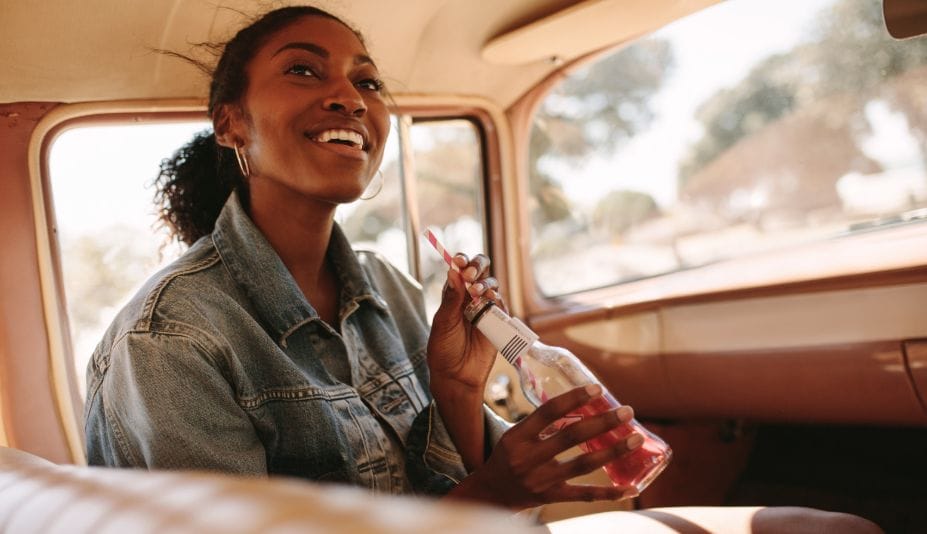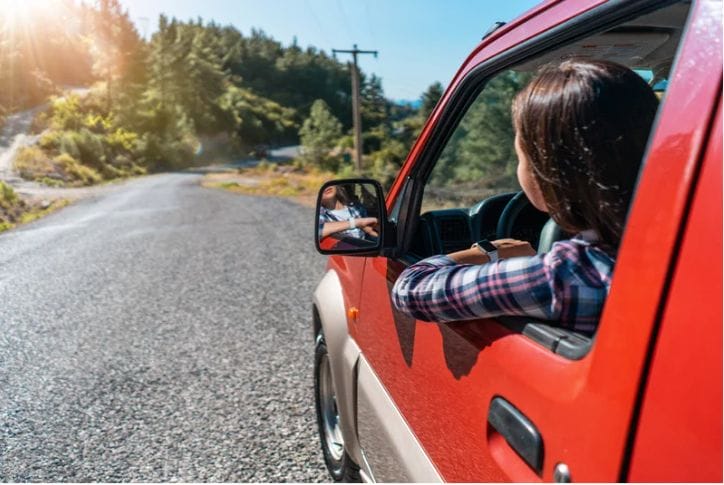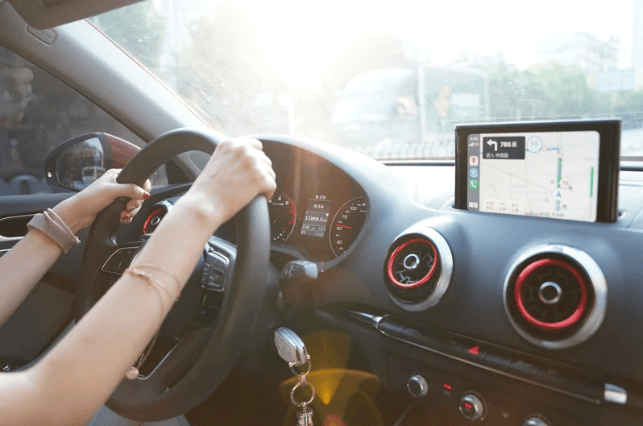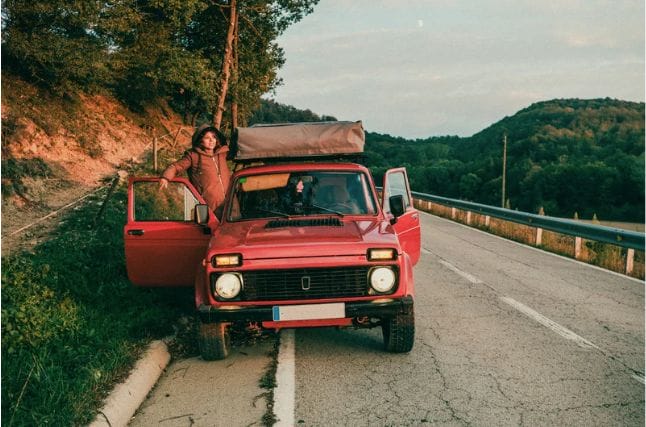
Taking to the open road alone as a woman can be an exhilarating adventure filled with freedom and self-discovery. You’re the DJ of your own soundtrack, the captain of your journey, and the sole decision-maker when that roadside attraction catches your eye. With women now making up nearly half of all solo travelers in the U.S., it’s clear that independent exploration is on the rise.
While the highway beckons with promise, smart travelers know that preparation transforms potential worries into confident adventures. A staggering 80% of breakdowns can be prevented with simple pre-trip vehicle inspections. Road trip safety tips are not just about planning for both daylight drives and nighttime journeys, they are also about sharing your itinerary with trusted contacts, and using technology as your virtual travel companion are essential strategies for the savvy solo explorer.
The highway is waiting, and with the right preparation, you’ll be ready to embrace every mile with confidence.
Key Takeaways to Road Trip Alone as a Female Traveler
- Vehicle maintenance checks before your trip can prevent 80% of roadside emergencies.
- Women now make up nearly 50% of solo travelers in the U.S.
- Avoid driving at night when visibility is worse and fewer people are around to help if you have car trouble.
- Share your route, stops, and hotel details with a trusted friend.
- Travel safety apps like bSafe and Life360 let friends track your location in real time, but always keep a paper map as backup.
Preparing Your Road Trip as a Solo Female Traveler
Planning ahead is the foundation of any successful solo adventure on the open road. A well-prepared journey not only minimizes potential risks but also maximizes your enjoyment and peace of mind. Before you feel that first rush of freedom with the windows down and your favorite playlist pumping, take time to create a comprehensive pre-trip strategy. This preparation phase covers everything from ensuring your vehicle is road-worthy to packing essential safety items and mapping a journey that balances adventure with security. Your future self will thank you for the hour or two spent on preparation when you’re confidently cruising toward your destination without preventable worries weighing you down.
PRE-TRIP VEHICLE SAFETY CHECKLIST
LIGHTS & VISIBILITY
- Headlights are bright and functioning
- Brake lights work when pedal is pressed
- Turn signals flash properly
- Hazard lights activate correctly
- Mirrors are properly positioned and clean
- Windows are clean and free of cracks
- Windshield wipers clear without streaking
- Washer fluid is topped off
TIRES & WHEELS
- Tire pressure matches recommended PSI (including spare)
- Tread depth passes the quarter test (insert a quarter upside down; if you can see the top of Washington’s head, replace the tire)
- Spare tire is in good condition
- Tire changing tools are present and you know how to use them
- Wheel lug nuts are tight
UNDER THE HOOD
- Oil level is between min/max marks
- Coolant/antifreeze is filled properly
- Battery is secure with clean terminals
- Battery age is less than 3-4 years
- Belts show no cracks or fraying
- Hoses are firm with no leaks
BRAKES & PERFORMANCE
- Brake pedal feels firm (not spongy)
- No squeaking or grinding when braking
- No pulling to either side when braking
- Parking brake holds the vehicle in place
FUEL & ESSENTIALS
- Gas tank filled to at least half
- Gas cap seals properly
- Scheduled maintenance is up to date
- No warning lights illuminated on dashboard
🗣️ REAL TRAVEL LESSONS FROM READERS
“I once got pulled over in North Carolina because my brake light was out. A 30-second pre-trip check could have prevented this stressful encounter.”
“Running out of washer fluid during a dust storm near the Grand Canyon taught me to never skip fluid checks before a trip.”
“Standing on the side of a remote highway changing a flat tire alone isn’t fun. Now I always verify my spare is properly inflated before leaving home.”
“I skipped a brake check before a cross-country trip and spent three days stranded in a small town waiting for parts. The $50 pre-trip inspection would have saved me hundreds.”
💡 PRO TIP: Find a trusted mechanic for a complete inspection if your journey covers more than 1,000 miles. The peace of mind is worth every penny!

Gather Essential Safety Gear
Road trips offer freedom and adventure, but smart female travelers never leave home without proper safety gear. I packed my car with essential items last year that saved me from several sticky situations during my trip through the American Southwest.
EMERGENCY & FIRST AID
- First aid kit with bandages, antiseptic wipes, pain relievers, and personal medications
- Roadside emergency kit including jumper cables and reflective triangles
- Basic tools (screwdrivers, pliers, wrench set)
- Flashlight with extra batteries
- Window breaker and seatbelt cutter tool mounted within reach
- Multi-tool or Swiss Army knife for quick fixes
“My roadside emergency kit saved me when my battery died at a state park with no cell service. The jumper cables and reflective triangles were essential.”
PERSONAL SAFETY
- Pepper spray or personal alarm that fits in pocket or purse
- Blanket and extra clothes for unexpected weather or overnight needs
- Snacks and water bottles for nourishment between rest areas
- Spare car key hidden in magnetic box on vehicle exterior
TECH & NAVIGATION
- Portable phone charger with sufficient capacity
- Car charger adapter with USB ports
- Paper maps or road atlas as backup
- Portable GPS device (optional backup to phone)
“Google Maps let me down in South Dakota when I lost cell service, but my backup road atlas guided me safely to my destination.”
VEHICLE MAINTENANCE
- Tire pressure gauge
- Portable air compressor
- Tire sealant/fix-a-flat
- Duct tape and WD-40 (for temporary fixes)
- Spare fuses specific to your vehicle
“When my tire pressure light came on in the middle of nowhere, my portable air compressor meant I could add air myself instead of driving on a dangerous underinflated tire.”
💡 PRO TIP: Create a dedicated “road trip safety box” that stays in your vehicle, and check it before each major trip to restock supplies and verify everything works properly.

Map Out Your Route and Book Accommodations
Planning your route ahead makes your solo road trip safer and more enjoyable. Your travel plans should include where to stay each night to avoid last-minute stress.
- Plan your daily driving distances – limit yourself to 4-6 hours per day to prevent fatigue and enjoy roadside attractions along the way.
- Book accommodations in advance – this gives you a safe place to rest each night and helps friends track your travel plans.
- Take screenshots of your route – offline maps can save you if cell service fails in remote areas or national parks.
- Choose well-lit, busy gas stations for stops – these spots offer more safety than isolated rest areas, especially for a single woman traveler.
- Share your route plan with a family member or best friend – text them your next stop and estimated arrival times daily.
- Research safe areas in each destination – read blog posts from other female solo travelers about neighborhoods to avoid.
- Mark mile markers and exits on your route – these reference points help during emergency calls if you need assistance.
- Pick hotels with interior room access – avoid motels where rooms open directly to parking lots for added security.
- Make daytime arrivals a priority – checking into accommodations before dark gives you time to assess the surroundings.
- Create a backup plan for each travel day – know alternative routes and lodging options if your original plans change.

Driving Safely on Your Solo Road Trip
Driving safely on your road trip means planning ahead and staying alert. You’ll face many hours behind the wheel, so your safety habits matter even more when you’re traveling alone.
Skip Nighttime Driving
Darkness creates extra risks for solo female travelers on road trips. Your vision gets worse at night, making it harder to spot road hazards or read signs. Plus, fewer people are around if you need help with car trouble.
Night driving also increases your chances of meeting drunk drivers, especially after 10 PM on weekends.
Plan your travel days to reach your stop before sunset. If you must drive after dark, stick to well-lit main roads and keep your doors locked. Gas stations and rest stops have fewer visitors at night, which might put you in unsafe spots.
Your first solo road trip will feel much safer when you travel during daylight hours – this simple change can make your travel experience more enjoyable and secure.
Break Regularly to Maintain Alertness
Long stretches of driving can make you tired and less alert – a danger for any solo female traveler. Plan stops every 2-3 hours to refresh your mind and body. These breaks don’t need much time – just pull into a rest area, gas station, or coffee shops to stretch your legs and clear your head.
Your travel time might increase slightly, but your safety is the most important thing.
During these stops, try simple exercises to boost your energy. Jumping jacks, quick walks, or even face-splashing with cold water can help. Many state parks along highways offer perfect spots for short breaks in nature.
Listening to audio books or switching radio stations can also keep your brain active between stops. This simple road trip tip has saved many solo travelers from the dangers of highway hypnosis.
Navigate with GPS and Offline Maps
GPS apps make road trips much easier for solo female travelers. You can use Google Maps or Waze to find the fastest routes and avoid traffic jams. Download offline maps before you hit the road – this simple step will save you if cell service drops in rural areas.
Many apps now show gas stations, rest stops, and safe places to park along your route. Your phone becomes a useful tool that helps you stay on main roads and avoid sketchy dirt roads.
Keep your GPS device mounted where you can see it without taking your eyes off the road for too long. This setup gives you the freedom to explore new places while staying safe during your spontaneous road trip.

Personal Safety Strategies for Solo Female Travelers
Personal safety matters most during your solo road trips – learn smart ways to protect yourself, carry self-defense tools, and keep friends updated on your travels.
Equip Yourself with Self-Defense Tools
You need some basic self-defense tools on your solo road trip. A small can of pepper spray kept in your car door pocket gives you quick access in tight spots. I always carry mine when stopping at rest areas or gas stations after dark.
Other useful items include a personal alarm that clips to your keychain and makes a loud noise when pulled. During my first solo trip across the country, these tools gave me peace of mind at each stop.
Don’t forget a sturdy flashlight – it works as both a light source and a striking tool if needed. Many travel guides suggest these items as must-haves for women exploring new places alone.
Be Alert and Trust Your Instincts
Your gut feelings serve as a built-in alarm system during solo road trips. Pay close attention to your surroundings at rest stops, gas stations, and hotels – these spots can make you feel unsafe if something seems off.
Many female travelers report that their instincts warned them about risky situations before any clear danger appeared. Step away from any person or place that gives you a weird vibe, even if you can’t explain why.
This isn’t about being afraid; it’s about staying smart on the open road.
Trust yourself enough to change plans if needed. Your comfort zone might stretch during a day trip or first road trip, but safety always comes first. Pull into a busy store parking lot instead of a dark, empty one.
Skip that remote scenic spot if no other cars are around. Female travelers often face unique safety concerns, so staying alert isn’t paranoid – it’s a great way to enjoy your adventure while keeping yourself safe.
The best way to handle potential trouble is to avoid it completely by listening to that inner voice.
Inform a Friend of Your Travel Plans
Always tell someone you trust about your road trip plans. Share your route, stops, and hotel details with a close friend or family member before you leave. Text them daily check-ins at set times so they know you’re safe.
If you miss a check-in, they’ll know something might be wrong. Many travelers use apps like Find My Friends or Life360 that track your location in real time. This simple step creates a safety net during your solo adventure.
For extra protection, send photos of your rental car and license plate to your contact person. This practice has helped many women feel more secure on their spontaneous solo road trips across different cultures and new places.

Use Technology for Enhanced Road Safety
Technology can be your best friend during solo road trips. Your smartphone can help you stay safe with apps that track your location and send alerts if needed.
Utilize Safety Apps for Alerts and Tracking
Safety apps can be your best friend during solo road trips. Apps like bSafe, Life360, and SafeTrek let you share your location with trusted friends in real time. You can set up these apps to send automatic alerts if you don’t check in at planned times.
Many offer one-touch emergency buttons that contact help and share your exact spot if you feel unsafe. Your everyday life might not include these tools, but they make a long way toward peace of mind on the open road.
Download a few before your trip and test them with a friend to make sure they work in the areas you’ll visit.
Your phone becomes a powerful safety tool with the right apps installed. Make sure to keep your credit cards and phone in different spots in case one gets lost. Some apps can even track road conditions and warn you about bad weather ahead – a good idea for any first time solo traveler.
The past years have seen great growth in apps made just for women on the road, with many offering tips from other female travelers who share their experiences through these platforms.
Keep Your Phone Charged with a Backup Power Source
Your phone becomes your lifeline during solo road trips. I learned this the hard way last year near San Diego when my battery died just as I needed directions to my hotel. Always pack a portable power bank that can charge your phone at least twice.
These small devices fit easily in your glove compartment or purse and provide peace of mind. Many good ones cost under $30 – a small price for such an important item.
Car chargers are also must-haves for any road trip. Plug your phone in while driving to keep it at 100%. For longer trips through remote areas, solar chargers make great backup options.
They might seem like extra gear, but you’ll thank yourself if you get stuck somewhere without power. Your phone helps you find gas stations, call for help in case of an emergency, and stay connected with friends tracking your journey.
Final Thoughts
The open road offers incredible freedom for solo women travelers. With thoughtful preparation, awareness, and the right tools, you can embrace adventure while staying safe. Remember that confidence comes from preparation—and prepared travelers have the most enjoyable experiences.
Your solo journey is about embracing independence while making smart choices. Each trip builds your travel skills and creates unforgettable memories. I hope these Road Trip Safety Tips will help you embrace the road!
FAQs
1. What are the best places for first-time solo female road trippers?
The best places for beginners are often well-traveled routes with good cell coverage and plenty of stops. Avoid remote areas for your first place to explore. The middle east of the US offers many scenic drives with regular towns and services.
2. What important items should I pack for safety?
Pack road atlases as backup for GPS, a first aid kit, car repair basics, and a portable phone charger. Your insurance company info and roadside assistance numbers are must-haves. For solo camping trips, bring extra security items like door stops and personal alarms.
3. How can I connect with other female travelers?
Join a Facebook group for women travelers to make new friends and get advice. Many camper vans owners have online communities too. These groups share the best tips and can help a better person understand safety concerns in different areas.
4. Should I share my trip on social media?
Posting about your short trip on social media has good things and bad things. Wait to post photos until after leaving a location rather than announcing where you are in real time. This gives you the perfect way to share your adventure while staying safe.

